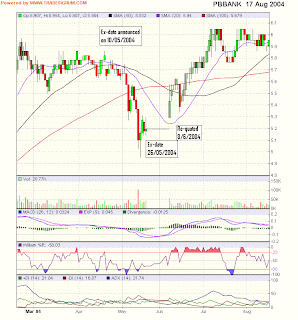In my post in December last year, I had noted that "...(for) 1Q2009, Sime secured a lower average crude palm oil price of RM2,962 per tonne compared to preceding quarter of RM3,285 per tonne. How would Sime perform in the next quarter, given that CPO prices are trading at RM1,600 per tonne presently? The operating margin of Sime's Plantation division is about 28% (i.e. operating profit of RM968.2 million over turnover of RM3.491 billion for 1Q2009). Since the present CPO prices are 54% lower than Sime's CPO average prices for 1Q2009, this means that Sime could make a loss in its Plantation division for 2Q2009." That was a mistake- an over-simplification of Sime's Plantation operation that ignored its many downstream businesses.
I carried on with that mistake to the next post in February this year, where I have noted that "...Sime's Plantation division has managed to stay in the black & to chalk up an operating profit of RM140 million for 2Q2008 due to two reasons, i.e. better average CPO of RM1,770 per tonne and higher volume sold (1,454 tonnes sold for 2Q2009 as compared to 1,179 tonnes sold for 1Q2009)". The unamended table (then, named Table 3) is included for illustration purpose only.

Table 3: Sime's last 4 quarters' Plantation Division's Performance
Certain portion of the above 2 passages (highlighted in bold) are incorrect. In particular, the computation of the volume of CPO produced in the above table by a simple division of the Plantation division's turnover by the average CPO price would result in a higher figure for the volume of CPO produced (as the value added by downstream operating units was ignored). In addition, it is inaccurate to compare the average operating margin of Plantation division (which stood at 27.7% & 5.4% for QE30/9/2008 & QE31/12/2008, respectively) with the fall in CPO prices, in order to draw any conclusion regarding the level of profits or losses to be recorded by the Plantation division. It is possible that Sime's upstream operation could incur some losses if CPO prices were to drop below RM1,400, but its downstream operation could be profitable. Whether the profit from the downstream operation is enough to buttress the losses (if any) from the upstream operation is a different question. Fortunately, we do not have to address our mind on this matter because Sime managed to record an average operating margin for its Plantation division of 5.4% for QE31/12/2008 even when its average CPO prices was at RM1,770 per tonne. Today, CPO prices are about RM1,900-2,000 per tonne but prices are forecast to be lower for the second half of the year (go here).
Technical Outlook
Sime appears to be forming a base between RM5.00-6.00 for the past 4 months. From the weekly chart (Chart 1 below), we can see that 10-week SMA has swung up & it looks set to cross above the 20-week SMA any time. This could happen if Sime were to go above the RM6.00 mark.

Chart 1: Sime's weekly chart as at 30/3/2009 (Source: Quickcharts)
I have also appended the monthly chart below (see Chart 2). If we draw an uptrend line from 1988- skipping the trough of 1998- we can see that this uptrend line was tested in December last year. This long-term uptrend line support is at RM4.90-5.00.

Chart 2: Sime's monthly chart as at 30/3/2009 (Source: Quickcharts)
I think that Sime could be a good long-term investment. A comfortable entry level would be at RM5.00-5.50 level.












































